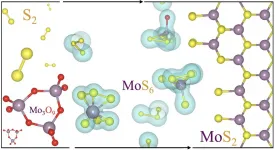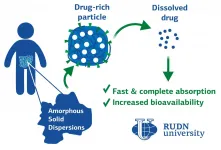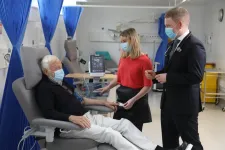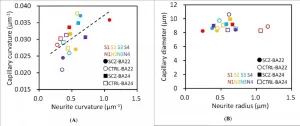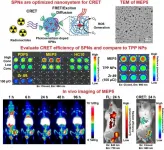Clinical trial shows cell therapy improves clinical outcomes in heart failure
UofL led enrollment for trial that showed a reduction in hospitalizations and improved quality of life for heart failure patients
2021-06-14
(Press-News.org) LOUISVILLE, Ky. - A clinical trial conducted at the University of Louisville has shown for the first time that heart failure treatments using cells derived from the patient's own bone marrow and heart resulted in improved quality of life and reduced major adverse cardiac events for patients after one year.
"This is a very important advance in the field of cell therapy and in the management of heart failure. It suggests that a treatment, given only once, can produce long-term beneficial effects on the quality of life and prognosis of these patients," said Roberto Bolli, M.D., director of the UofL Institute of Molecular Cardiology, who led the study at UofL. "The results pave the way for a larger, Phase 3 trial of cell therapy in heart failure."
UofL led enrollment among seven institutions participating in CONCERT-HF, a Phase 2 clinical trial testing the safety, feasibility and efficacy of two types of adult cells, used alone and in combination, in patients with heart failure.
CONCERT-HF evaluated the use of two types of cells - autologous mesenchymal stromal cells (MSCs) and c-kit positive cardiac cells (CPCs) - alone or in combination, in patients with heart failure caused by chronic ischemic cardiomyopathy, a decrease in heart pumping effectiveness due to heart attacks and a lack of blood getting to the heart. Autologous MSCs are derived from the patient's bone marrow and CPCs are from the patient's heart tissue. Both are known as "autologous" cells because they come from the same patient in whom they are returned for the treatment.
In the study, patients treated with CPC cells alone had a significant reduction in major adverse cardiac events, particularly hospitalization. Patients treated with MSC cells alone and with a combination of both types of cells experienced significantly improved quality of life compared with patients who received no treatment. Quality of life was assessed using patient responses to the Minnesota Living with Heart Failure Questionnaire, which gauges the degree to which physical, emotional and socioeconomic effects of heart failure adversely affect the patient's life and the extent to which they prevented the patient from living as they wanted to live.
"The results of this trial show for the first time that cell therapy reduces hospitalization for heart failure and improves clinical outcome, providing a cogent rationale for undertaking a pivotal Phase 3 trial" that could be the next step on the pathway to FDA approval, Bolli said.
The results of the CCTRN CONCERT-HF Trial were published in the European Journal of Heart Failure. The Phase 2, randomized, placebo-controlled trial, funded by NIH National Heart, Lung and Blood Institute, was conducted by the Cardiovascular Cell Therapy Research Network (CCTRN), a network of clinical trial researchers involved in cell therapy for heart disease that includes UofL. UofL led enrollment in the study, accounting for 25% of the 125 trial participants.
Bolli's expertise and long career in successful cardiac research led to the establishment of the CCTRN center at UofL in 2011. This consortium of leading cardiovascular research organizations includes Stanford University, the University of Miami, Indiana University, the Texas Heart Institute, the University of Florida and the Minneapolis Heart Institute Foundation in addition to UofL. The School of Public Health at the University of Texas Health Science Center at Houston serves as the data coordinating center.
Bolli is a pioneer in research using adult stem cells for cardiac disease. Over the past two decades, he has shown that CPCs are beneficial in many preclinical models of heart failure, thus paving the way for the CONCERT-HF trial. He also led the recent CCTRN SENECA Trial - the first study to show safety and potential efficacy of cell therapy in cancer survivors with heart failure caused by anticancer therapy.
INFORMATION:
ELSE PRESS RELEASES FROM THIS DATE:
2021-06-14
HOUSTON - (June 11, 2021) - Scientific studies describing the most basic processes often have the greatest impact in the long run. A new work by Rice University engineers could be one such, and it's a gas, gas, gas for nanomaterials.
Rice materials theorist Boris Yakobson, graduate student Jincheng Lei and alumnus Yu Xie of Rice's Brown School of Engineering have unveiled how a popular 2D material, molybdenum disulfide (MoS2), flashes into existence during chemical vapor deposition (CVD).
Knowing how the process works will give scientists and engineers a way to optimize the bulk manufacture ...
2021-06-14
RUDN University scientists together with colleagues from Switzerland proved in a clinical trial the effectiveness of a new dosage form -- amorphous solid dispersion. This is the first such study in humans to show the mechanism of action of this form of drug release. In the future, it will help to increase the effectiveness of drugs and use new active substances for treatment. The results of the study are published in Pharmaceuticals.
One of the main reasons for the dropout of new oral drugs at the preclinical and clinical stages of development is low bioavailability. The drug itself can be effective, but it is poorly absorbed in the body because of its low solubility. Amorphous solid dispersion (ASD) is a new ...
2021-06-14
The 17-year cicadas emerging dramatically by the billions in 15 U.S. states from Georgia to New York and west to Illinois are making quite a racket--a uniquely North American phenomenon--but thousands of other cicada species on the planet also spend most of their lives underground, many of them emerging below the radar of human perception. Because most cicada species don't emerge simultaneously like species in the genus Magicicada--the periodical cicadas--little is known about their natural history. Driven by unusual attention to detail and curiosity, Annette Aiello, staff entomologist at the Smithsonian Tropical Research Institute (STRI) in Panama, joined a very select group of ...
2021-06-14
Environmental bacteria and fungi that end up in the belly of honeybees may be essential to their survival in a changing world as bee populations dwindle due to pesticides, poor nutrition, habitat destruction and declining genetic diversity.
Like many animals, bees have an internal armory. Their guts are home to a multitude of microbes that perform vital functions, from aiding digestion to breaking down toxins and fending off parasites. "A healthy gut microbiota makes bees more resilient to threats such as pathogens and climate change," says KAUST research scientist Ramona Marasco, "highlighting the need to understand how different microbes help their host."
Extensive research into the microbiome ...
2021-06-14
Some 42% of patients attending a dedicated diabetes clinic have signs of established chronic kidney disease, the first detailed research of its kind in Ireland has revealed.
The study was carried out by academics at NUI Galway and clinicians at University Hospital Galway Diabetes Centre and involved more than 4,500 patients in the west of Ireland.
The findings suggest that, despite careful medical management, a relatively high proportion of people with diabetes in Ireland are developing chronic kidney disease over time and are at risk of kidney failure and other complications of poor kidney function.
Diabetes ...
2021-06-14
Drs. Itokawa, Mizutani and colleagues performed microtomography experiments the BL20XU beamline of the SPring-8 synchrotron radiation facility and found that brain capillary structures show a correlation with their neuron structures.
Brain blood vessels constitute a micrometer-scale vascular network responsible for supply of oxygen and nutrition. In this study, we analyzed cerebral tissues of the anterior cingulate cortex and superior temporal gyrus of schizophrenia cases and age/gender-matched controls by using synchrotron radiation microtomography or micro-CT in order to examine the three-dimensional structure of cerebral vessels.
All post-mortem human cerebral tissues were collected ...
2021-06-14
A new species of large prehistoric croc that roamed south-east Queensland's waterways millions of years ago has been documented by University of Queensland researchers.
PhD candidate Jorgo Ristevski, from UQ's School of Biological Sciences, led the team that named the species Gunggamarandu maunala after analysing a partial skull unearthed in the Darling Downs in the nineteenth century.
"This is one of the largest crocs to have ever inhabited Australia," Mr Ristevski said.
"At the moment it's difficult to estimate the exact overall size of Gunggamarandu since all we have is the back of the skull - but it was big.
"We estimate the skull would have been at least 80 centimetres long, and based on comparisons with living crocs, this indicates a total ...
2021-06-14
Summer picnics and barbecues are only a few weeks away! As excited as you are to indulge this summer, Escherichia coli bacteria are eager to feast on the all-you-can-eat buffet they are about to experience in your gut.
However, something unexpected will occur as E. coli cells end their journey through your digestive tract. Without warning, they will find themselves swimming in your toilet bowl, clinging to the last bits of nutrients attached to their bodies. How do these tiny organisms adapt to survive sudden starvation? Scientists at Washington University in St. Louis wondered.
Close examination of nutrient-deprived E. coli ...
2021-06-14
Reston, VA (Embargoed until 12:30 p.m. EDT, Monday, June 14, 2021) - Researchers have successfully developed a novel cancer treatment approach that utilizes Cerenkov radiation energy to target and destroy cancer cells more effectively. The approach uses light from decaying radiopharmaceuticals, known as Cerenkov luminescence, as an energy source to activate semiconducting polymer nanoparticles that kill cancer cells. This research was presented at the Society of Nuclear Medicine and Molecular Imaging's 2021 Virtual Annual Meeting.
Over the past several decades, many studies have been conducted on photodynamic therapy, ...
2021-06-14
Alzheimer's disease is the most common form of dementia and is characterized by neurodegeneration in regions of the brain involved in memory and learning. Amyloid beta and tau are two toxic proteins that build up in disease and cause eventual neuronal death, but little is known about how other cells in the brain react during disease progression.
A new study from the ASU-Banner Neurodegenerative Research Center (NDRC) and MIT/Koch Institute sheds new light on how disease processes manifest in patients with Alzheimer's disease.
Diego Mastroeni of the NDRC teamed up Forest White and Douglas Lauffenburger, colleagues in MIT's Department of Biological Engineering, to explore how protein ...
LAST 30 PRESS RELEASES:
[Press-News.org] Clinical trial shows cell therapy improves clinical outcomes in heart failure
UofL led enrollment for trial that showed a reduction in hospitalizations and improved quality of life for heart failure patients
